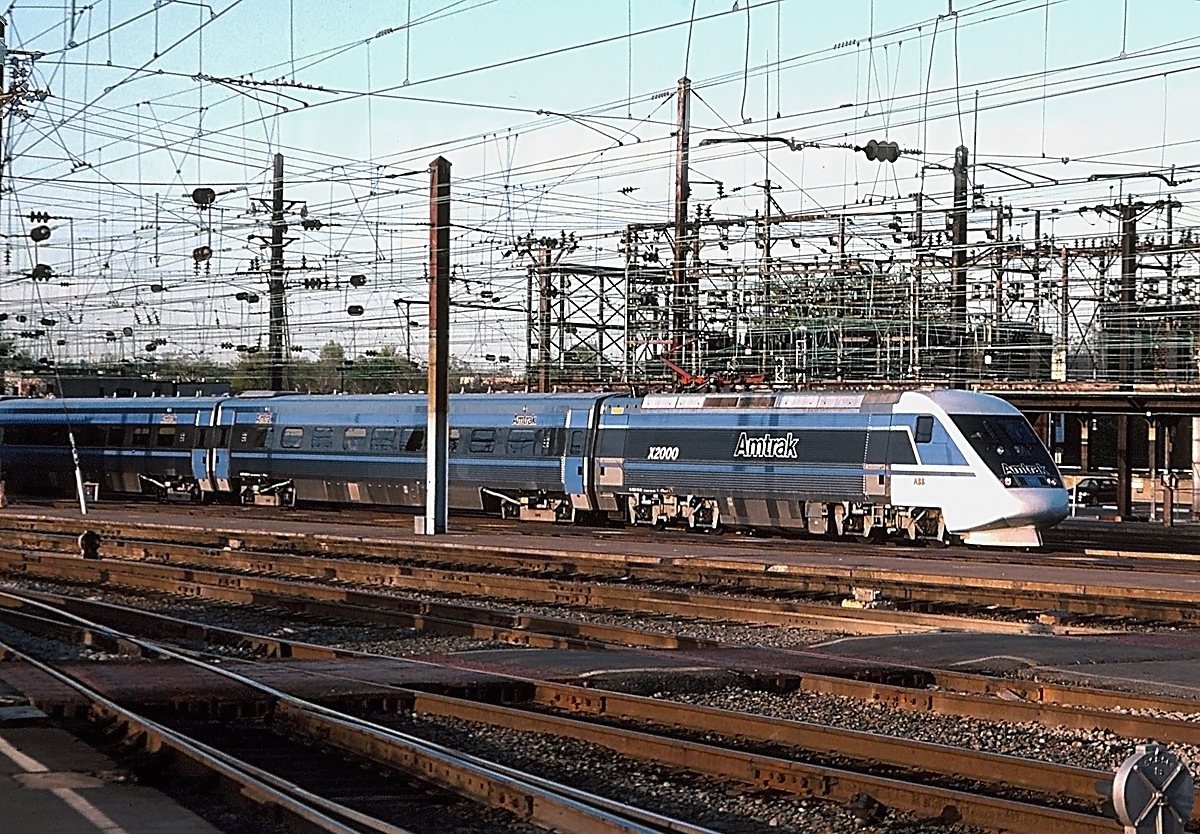Amtrak's "X2000" Trainset: Testing, Specs, History
Last revised: February 26, 2025
By: Adam Burns
The realm of high-speed rail beckons a blend of innovation, engineering finesse, and a relentless drive toward reducing travel times while enhancing passenger comfort.
Among the pioneers that rose to this challenge was Sweden's X2000, a trainset that epitomized these principles. Developed by the Swedish State Railways (SJ) and manufactured by Asea Brown Boveri (ABB) and Kalmar Verkstad, the design emerged as a testament to the possibilities of modern rail transport.
Noteworthy is its transatlantic journey to the United States, where it was tested by Amtrak on the Northeast Corridor in 1992-1993 during the carrier's intentions to introduce high speed service along its busiest sector.
 The X2000 tests on Amtrak with a southbound run as it works its way through the intricate trackage of Washington Union Station on April 28, 1993. Wade Massie photo.
The X2000 tests on Amtrak with a southbound run as it works its way through the intricate trackage of Washington Union Station on April 28, 1993. Wade Massie photo.Genesis
The X2000 first entered service in 1990 and was desigend to operate on Sweden's conventional rail infrastructure at high speeds, primarily focusing on the Stockholm-Gothenburg line.
The train's most distinguishing feature was its tilting technology, intended to handle curves at higher speeds than traditional trains by tilting the cars inwards on curves, thus reducing lateral forces experienced by passengers.
Each X2000 trainset consisted of a power car and several passenger cars, orchestrated to deliver a seamless blend of speed and comfort.
These trains could reach speeds up to 200 km/h (124 mph) and were equipped with luxurious interiors that included adjustable seating, climate control, and an on-board bistro, making them an attractive alternative to air travel within Sweden.
Amtrak’s Bid for High-Speed Rail
In the early 1990s, Amtrak was in pursuit of high-speed rail solutions to bolster its Northeast Corridor, which spanned key metropolitan hubs from Washington, D.C., to Boston. Recognizing the potential of the X2000, Amtrak embarked on a series of tests to determine its suitability for American tracks and passenger preferences.
Preparation and Modifications
The journey of the X 2000 to the United States began with careful planning and necessary modifications to adapt the Swedish trainset to American rail standards. Notably, this included adjustments to handle the signaling systems and power supply of the Northeast Corridor, which operated on 11 kV, 25 Hz electrification—differing from Sweden's system of 15 kV 16.7 Hz AC.
In preparation for its American debut, the X2000 was shipped overseas and modified to ensure it could operate efficiently on U.S. tracks while still delivering the performance and comfort for which it was renowned.
Testing the Waters: The Amtrak Trials
The creators of the X2000 were eager to showcase its high-speed magic beyond Sweden's borders in hopes of selling the design internationally.
While foreign sales ultimately proved elusive, it did test in several countries including Norway, Finland, Germany, Austria, France, China, Australia, Portugal, and the United States.
Commencing in late 1992, the X2000 embarked on an extensive series of tests on the Northeast Corridor (NEC). Following tests from October 1992 until January 1993, the train went into revenue service on the bustling NEC.
For about five months—from February to May and from August to September 1993—it zoomed between New Haven, Connecticut, and Washington, D.C., via New York City.
Between May and July, it embarked on an expansive national tour, making demonstration stops at key stations across the continental United States. This grand tour even included parts of Canada, showcasing the train's capabilities to a North American audience eager for a glimpse of high-speed rail's potential.
Test Routes and Performance Metrics
Performance metrics gathered during the tests focused on several key aspects:
1. **Speed and Efficiency:** Demonstrating the ability to maintain high speeds on the existing rail infrastructure.
2. **Tilting Technology:** Evaluating the efficiency of the tilting mechanism on sharp curves prevalent in the Northeast Corridor.
3. **Passenger Comfort:** Assessing ride quality, noise levels, and overall passenger experience.
4. **Operational Reliability:** Ensuring the train’s consistent performance in diverse weather and track conditions.
Passenger Trials and Public Reception
A crucial component of the tests involved passenger trials. Amtrak invited the public to experience the train first-hand, offering services that mimicked regular operations. These trials provided invaluable feedback on passenger comfort, amenities, and overall impression of high-speed rail.
The public reaction to the was overwhelmingly positive. Passengers lauded the train's smooth ride, notably the effectiveness of the tilting technology in minimizing the discomfort typically associated with high-speed travel on curved tracks.
The interior design, complete with ergonomic seating and modern amenities, was favorably compared to the conveniences offered by air travel.
Challenges and Technical Insights
While the X2000 showcased impressive performance, the tests were not without challenges. Integrating the technology within Amtrak's infrastructure posed several hurdles, shedding light on areas requiring further investment and adaptation.
- **Track Compatibility:** While the Northeast Corridor was capable of supporting high-speed operations, sections of the track required upgrades to fully leverage the X2000's capabilities.
- **Regulatory Compliance:** Adhering to American safety standards and regulatory requirements necessitated additional alterations and adjustments.
- **Maintenance and Training:** Introducing new high-speed technology demanded specialized maintenance practices and comprehensive training for Amtrak staff, adding layers of complexity to the adoption process.
Legacy and Influence on Amtrak’s Future
Although Amtrak ultimately decided against the purchase of the X2000 following the test period, the trials played an influential role in shaping the carrier's high-speed rail strategy. The insights gained from the performance, passenger feedback, and operational challenges informed the development of future high-speed services.
The lessons from the tests contributed to the conceptualization and eventual launch of the Acela Express, Amtrak’s flagship high-speed service introduced in 2000. The Acela aimed to deliver a similar blend of speed and luxury, drawing on the knowledge accrued during the X2000 evaluations.
Beyond America: The Global Impact of the X2000
The tests in the US were part of a broader effort to position Sweden’s innovation in the global high-speed rail market. Despite not securing a contract with Amtrak, the X 2000 found success in other international markets.
China, for example, incorporated the tilting technology into their own high-speed rail systems, demonstrating the far-reaching impact of Swedish engineering.
Back in Sweden, the X2000 continued to be a cornerstone of the national rail network, consistently delivering high-speed services across major cities and playing a pivotal role in enhancing the efficiency of domestic travel.
Data Sheet
| Specifications | Details |
|---|---|
| Car body construction | Corrugated stainless steel |
| Train length |
457 feet, 5⁄8 inch (6 cars) 538 feet, 10 7⁄8 inches (7 cars) |
| Car length |
Power car: 56 feet, 7 3⁄8 inches Coaches: 81 feet, 10 1⁄4 inches Cab coaches: 73 feet, 1⁄8 inch |
| Width | 10 feet, 0 inches |
| Height | 12 feet, 6 1⁄8 inches |
| Floor height | Coach: 49 5⁄8 inches |
| Wheel diameter |
Power car: 43 5/16 inches Coach: 34 21/32 inches |
| Wheelbase |
Power Car: 29 feet, 5 3⁄8 inches Coaches: 58 feet, 7⁄8 inch Cab coach: 47 feet, 6 7⁄8 inches |
| Maximum speed |
Service: 125 mph Design: 130 mph Record: 171 mph |
| Weight |
Power car: 72 long tons; 80 short tons Coach: 46 long tons; 52 short tons Coach with bistro: 48 long tons; 54 short tons Control coach: 54 long tons; 61 short tons |
| Axle load | 17.2 long tons; 19.3 short tons |
| Power output | 4,370 HP |
| Tractive effort |
Power car: 36,000 Lbs (Starting) 24,000 Lbs at 67 mph (Continuous) |
| Electric system(s) | 15 kV 16.7 Hz AC + 25 kV 50 Hz AC catenary |
| Current collector(s) | Pantograph |
| Track gauge | 4 feet, 8 1⁄2 inches (standard gauge) |
Conclusion
The journey of the X 2000 to the United States, highlighted by the extensive tests carried out on Amtrak in 1992-1993, remains a significant chapter in the history of high-speed rail. It exemplified the potential of rail transport to redefine travel across regions, pushing the boundaries of speed, comfort, and technological integration.
While the X2000 did not become a permanent fixture on American tracks, its legacy lives on. The insights and advancements derived from these tests continue to influence high-speed rail developments, ensuring that the pursuit of faster, more comfortable, and efficient train travel remains a key objective for rail networks around the world.
Recent Articles
-
Minnesota Father's Day Train Rides: A Complete Guide
May 11, 25 12:16 AM
If you're in Minnesota and looking for a unique way to spend this day with your dad, consider taking a scenic train ride. -
Maine Father's Day Train Rides: A Complete Guide
May 10, 25 11:26 PM
This year for Father's Day, why not trade the conventional gifts and barbeque in for something exceptional—a scenic train ride across the beautiful state of Maine. -
Kentucky Father's Day Train Rides: A Complete Guide
May 09, 25 05:10 PM
Kentucky offers a variety of historic and scenic train excursions that provide an unforgettable way to honor and spend quality time with fathers.


